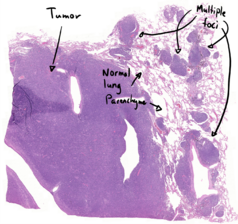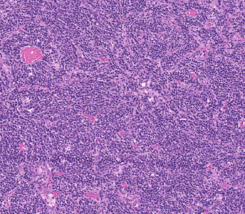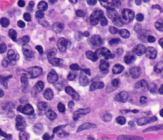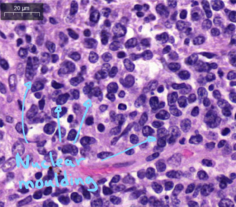49. Microcellular carcinoma of the lung: Difference between revisions
No edit summary |
No edit summary |
||
| (3 intermediate revisions by the same user not shown) | |||
| Line 1: | Line 1: | ||
[[File:Small cell lung cancer overview.png|thumb|Overview of the slide|238x238px]]'''Staining''': HE | [[File:Small cell lung cancer overview.png|thumb|Overview of the slide|238x238px]]'''Staining''': HE '''Organ''': Lung | ||
'''Organ''': Lung | |||
'''Description''': We can see some normal lung parenchyme that has been invaded by multiple foci. There is also a large tumor on the left of the slide. | '''Description''': We can see some normal lung parenchyme that has been invaded by multiple foci. There is also a large tumor on the left of the slide. | ||
The cells of the tumor are very small, and the tumor forms no structure. | The cells of the tumor are very small, and the tumor forms no structure. Some areas show cell with nuclei that “mold” into each other. Many mitotic figures are visible.[[File:Small cell lung cancer tumour cells.png|thumb|Close-up. The cells don’t form any structures (glands, layers).|245x245px]] | ||
The chromatin of the tumor cells is granular, making it look like salt and pepper. | |||
'''Diagnosis''': Small-cell lung carcinoma | |||
'''Risk factors''': Smoking | '''Risk factors''': Smoking | ||
| Line 17: | Line 13: | ||
'''Theory''': Small-cell lung originates from neuroendocrine cells in the lung. It gets its name from the fact that the tumor cells are really small. The cells also have very little cytoplasm. They’re pleomorphic and mitotic figures can also be seen. | '''Theory''': Small-cell lung originates from neuroendocrine cells in the lung. It gets its name from the fact that the tumor cells are really small. The cells also have very little cytoplasm. They’re pleomorphic and mitotic figures can also be seen. | ||
Nuclear moulding is a morphological sign where the nuclei of two cells appear to be in contact. This signs occurs because the cells have so little cytoplasm that the whole cell is basically just the nucleus, making it look like the cells’ nuclei are in contact. The fact that we have many small foci in addition to the large tumor is also characteristic for small-cell carcinoma.[[File:Small cell lung cancer mitosis.png|thumb|This poor cell was in the middle of dividing when it died.| | Nuclear moulding is a morphological sign where the nuclei of two cells appear to be in contact. This signs occurs because the cells have so little cytoplasm that the whole cell is basically just the nucleus, making it look like the cells’ nuclei are in contact. The fact that we have many small foci in addition to the large tumor is also characteristic for small-cell carcinoma.[[File:Small cell lung cancer mitosis.png|thumb|This poor cell was in the middle of dividing when it died.|163x163px]]Small-cell lung carcinoma has a much worse prognosis than non-small cell carcinoma (squamous and adenocarcinoma).A small-cell carcinoma is a type III neuroendocrine tumor. The salt-n-pepper morphology is characteristic for neuroendocrine tumors.[[File:Small cell lung cancer nuclear moulding.png|thumb|Nuclear moulding. Note the small size of the tumor cells. Note also their pleomorphism.|236x236px|none]] | ||
Small-cell lung carcinoma has a much worse prognosis than non-small cell carcinoma (squamous and adenocarcinoma).A small-cell carcinoma is a type III neuroendocrine tumor. The salt-n-pepper morphology is characteristic for neuroendocrine tumors. | |||
[[Category:Pathology 1 - Histopathology slides]] | [[Category:Pathology 1 - Histopathology slides]] | ||
Latest revision as of 13:09, 5 July 2024

Staining: HE Organ: Lung
Description: We can see some normal lung parenchyme that has been invaded by multiple foci. There is also a large tumor on the left of the slide.
The cells of the tumor are very small, and the tumor forms no structure. Some areas show cell with nuclei that “mold” into each other. Many mitotic figures are visible.

The chromatin of the tumor cells is granular, making it look like salt and pepper.
Diagnosis: Small-cell lung carcinoma
Risk factors: Smoking
Theory: Small-cell lung originates from neuroendocrine cells in the lung. It gets its name from the fact that the tumor cells are really small. The cells also have very little cytoplasm. They’re pleomorphic and mitotic figures can also be seen.
Nuclear moulding is a morphological sign where the nuclei of two cells appear to be in contact. This signs occurs because the cells have so little cytoplasm that the whole cell is basically just the nucleus, making it look like the cells’ nuclei are in contact. The fact that we have many small foci in addition to the large tumor is also characteristic for small-cell carcinoma.

Small-cell lung carcinoma has a much worse prognosis than non-small cell carcinoma (squamous and adenocarcinoma).A small-cell carcinoma is a type III neuroendocrine tumor. The salt-n-pepper morphology is characteristic for neuroendocrine tumors.

